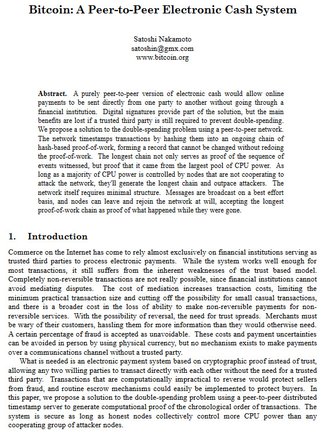“I’ve been working on a new electronic cash system that’s fully peer-to-peer, with no trusted third party.” (Satoshi Nakamoto, October 2008)
###
Satoshi Nakamoto (he/she/they?) created the first version of Bitcoin in the spring of 2007, which, in retrospect, seems prescient. A year later, the whole global financial system melted down into a recession, thanks to big investment banks (under the jurisdiction of the Federal Reserve) making irresponsible bets on unsecured mortgages. Bitcoin, which operates outside of a central authority (no “Bitcoin Headquarters” exists), suddenly seemed like an idea whose time had come.
Satoshi wrote soon after, “The root problem with conventional currency is all the trust that’s required to make it work. Banks must be trusted to hold our money and transfer it electronically, but they lend it out in waves of credit bubbles with barely a fraction in reserve.” You can read his 9-page “white paper” introducing Bitcoin here.

First page of Satoshi Nakamoto’s “white paper” issued October 31, 2008, describing Bitcoin and the blockchain.
But Bitcoin isn’t really the best (enlightened money!) or the worst (Ponzi scheme!) of Satoshi’s inventions. Whatever you think of Bitcoin (and its hundreds of copycat currencies), what Satoshi will be remembered for in the future is the blockchain, a brilliant way for anyone to communicate, safely and discreetly, with anyone else, without the need for a trusted third party. For instance, a single 324-gigabyte blockchain, perfectly copied on tens of thousands of computers across the globe, carries the timestamped record of every Bitcoin transaction since the first one on January 12, 2009 (at 18:15:05 UT, in case you’re keeping track). Anyone can download it. Read about how the blockchain works here.
So who is/are Satoshi Nakamoto? Not the unfortunate Japanese-American retired physicist Dorian Satoshi Nakamoto, who Newsweek fingered in 2014 as being the Satoshi. It was a case of mistaken identity, and the Bitcoin community rallied, donating $1 million to Dorian for the invasion of his toy-train-collecting privacy.
And probably not any of the other claimants, either. In fact, given that Satoshi owns about one million Bitcoin (worth $30 billion today), which has sat there, unused, “lost,” for over a decade, perhaps he is no longer in the land of the living. The last “for sure” communication from him/her/them was in April 2011, when an email to a developer friend said, “I’ve moved on to other things.” Since then, nada.
My best guess is that Satoshi died in 2011, soon after that email and another saying “I probably won’t be around in the future.” Len Sassaman, an American genius “cypherpunk” who committed suicide in Belgium that July, had been suffering from depression for some time. We may never know for sure, but enough members of the Bitcoin community believe Len was Satoshi that they erected an appropriate memorial to him: a testimonial embedded into Bitcoin’s blockchain.

CLICK TO MANAGE